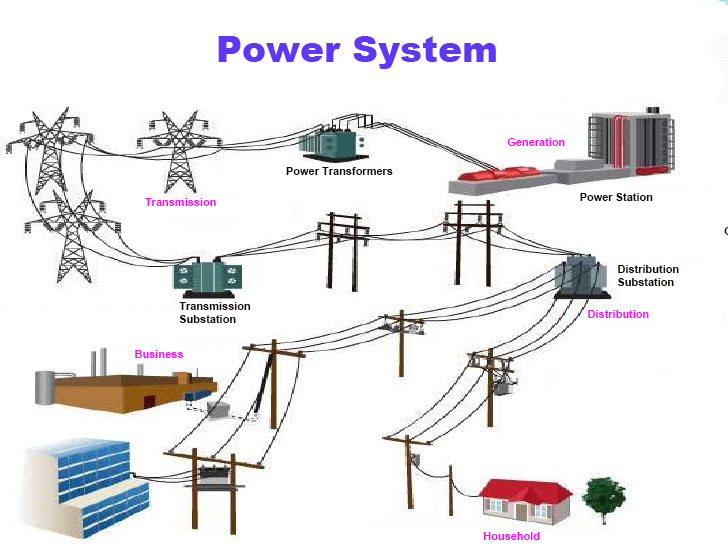The power system is a whole composed of power plants, power grids, electrical equipment and corresponding auxiliary systems according to the specified technical and economic requirements. The auxiliary systems include relay protection, safety automation, measurement, dispatch automation and communication devices.
In the composition of the power grid, transmission lines and distribution lines of different voltages are connected to each other through substations of corresponding voltage levels. Various electrical equipment such as power loads and lighting loads are connected to the low-voltage side of the distribution network. This forms a unified power system including power generation, overhead line hardware, and line construction connectors.
Basic Characteristic of Power System
Power System Frequency
The power system frequency is the frequency of the AC sinusoidal fundamental voltage produced by the synchronous generators of the power plants in the power system. Frequency quality is an important indicator of power quality. Under steady-state operation, the generators run synchronously, and the frequency of the entire power system is equal. It is a consistent operating parameter of the power system.
In the world, there are two rated frequencies used in power systems, 50Hz and 60Hz. Most countries in my country and the world use 50Hz power system. Only a few countries such as the United States, Canada, Cuba, and North Korea use 60Hz power systems. The eastern region of Japan is a 50Hz power system, and the central and western regions are a 60Hz power system. The two different frequency power systems are interconnected with the DC frequency conversion station.
Voltage Level of Power System
The voltage level is the rated voltage level series of the power system and power equipment. The rated voltage refers to the normal working voltage specified by the power system and power equipment. The actual operating voltage of each node of the power system is allowed to deviate from the rated voltage to a certain extent. Within the above allowable deviation voltage range, various power equipment and the entire power system can still operate normally.
In a power system, it is more reasonable to take 1.7~3.0 for the ratio of adjacent two-stage voltages. Therefore, in the above voltage levels, 35kV and 63kV, 63kV and 110kV should not coexist in the same regional power system.
Structure of Power Grid
The structure of the power network is related to the voltage level, the capacity and number of power sources and load points, the geographical location, the requirements for power supply reliability and other factors.
Capacity of Power System
The capacity of the power system is the sum of the rated capacity of all kinds of power plants in the system. Also known as system installed capacity. The installed capacity and geographical coverage of the power system reflect the scale of the power system.

Power Overload
Electrical load is the power consumed by all electrical equipment connected to the electrical system. It can be divided into active load and reactive load. Active power is the power actually consumed by electrical equipment in the process of converting electrical energy into other forms of energy (mechanical energy, light energy, thermal energy, etc.). For example, the power consumed by variable lights (converting electrical energy into light energy), electric furnaces (converting electrical energy into thermal energy), and motors used to drive machinery (converting electrical energy into mechanical energy) such as water pumps, windmills, lathes and rolling equipment is active power.
Reactive power is the power consumed by the establishment of a magnetic field during the electromagnetic energy conversion process when the motor and transformer are running. Therefore, reactive power and active power are equally important. Without reactive power, the motor cannot turn and the transformer cannot change the voltage.
Electricity cannot currently be stored on a large scale. Therefore, the power generated by the generator in the power system and the power consumed by the electrical equipment must always be kept in balance. The system load is constantly changing with time, and this change is usually represented by a load curve. In order to meet the needs of the system load, in addition to the load forecasting work, the power system should also be equipped with a certain amount of power generation backup capacity. In this way, the supply and demand of electricity can be kept in balance at any time.
Advantage of Power System
More Economical and Rational Development and Utilization of Large Power Resources
Under the condition that the receiving end has a large capacity, the sending end power plant installs large-scale generating units, and the operation is relatively safe after being connected to the power system.
Conducive to the adoption of large-capacity generator sets and the development of large-capacity power plants
Installing large units and building large power plants are important measures to save capital investment, speed up construction, reduce power generation costs and fuel consumption, and improve labor productivity. But for the power system with smaller capacity, the large unit will cause difficulty in system operation and maintenance. According to the proportion of system capacity increase, larger capacity units can be installed to improve investment efficiency and operating economy.
Improve Safety and Reliability of Power Supply
An increase in the capacity of the power system can cause the system to fail. At this time, the power of the systems in each region can support each other, reducing the impact on the entire system, thereby improving the reliability of the power supply of the system. However, the failure of individual links in the power system, if not eliminated in time, may expand the failure, resulting in a large-scale blackout accident in the power system. Therefore, in order to ensure the reliability of power supply, the power system must have a reasonable structure, improve the safety and reliability of each link, and improve the automation level of the entire system.
Improve Operating Economy
The various power plants in the power system operate in parallel. According to the principle of minimum power supply cost or minimum fuel consumption, economic dispatch and reasonable distribution of electricity among water, thermal and nuclear power plants are implemented. In this way, the maximum economic benefit of system operation can be obtained. In the joint power system, because the power supply cost of each power system is different, the implementation of economic dispatch can obtain additional economic benefits.


